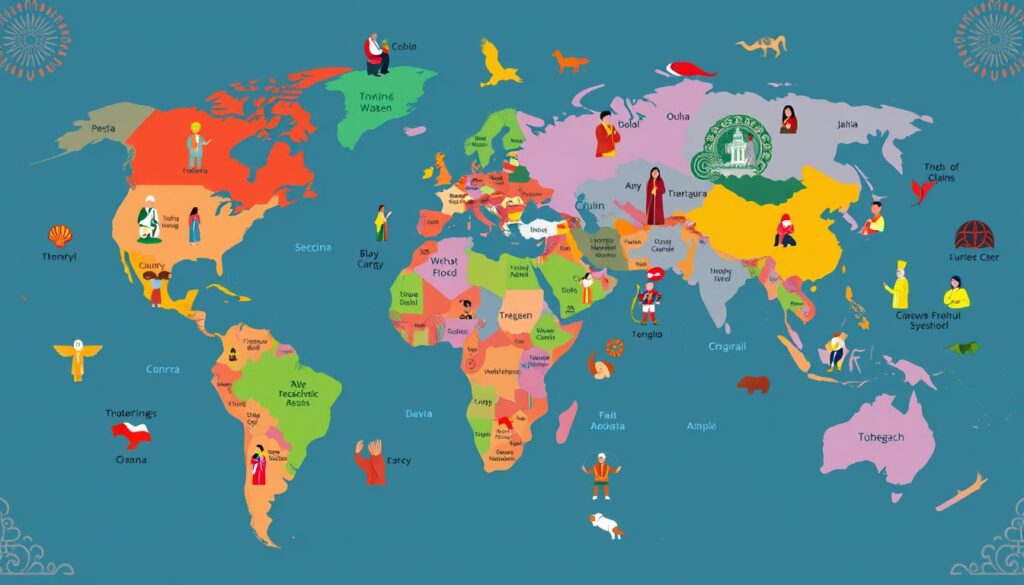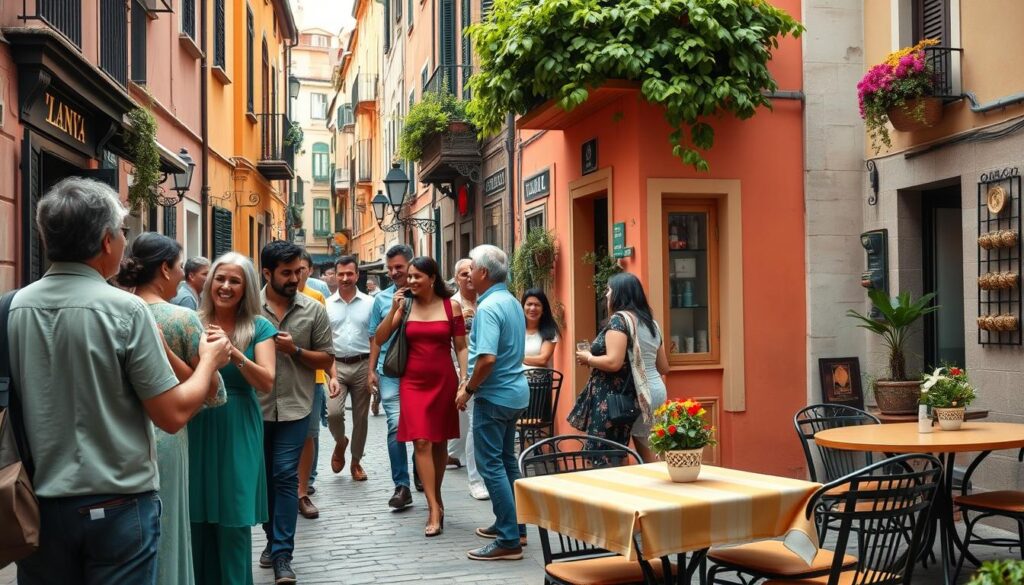In today’s global world, saying hello in someone’s native language can really help us connect. This article will show you how to say hello in many languages. From “Ni hao” in Mandarin Chinese to “Bonjour” in French, we’ll cover them all.
By learning about these greetings, you’ll be able to connect with people from all over. You’ll also make a great first impression. So, let’s dive into the world of greetings and explore their cultural meanings and how to say them right.

Key Takeaways
- Discover how to say hello in a variety of popular and lesser-known languages around the world.
- Understand the cultural context and significance of different greeting phrases.
- Learn the proper pronunciation of these essential greetings to communicate effectively with diverse audiences.
- Develop the skills to connect with people from different backgrounds and make a positive first impression.
- Expand your global communication abilities and broaden your cultural horizons.
The Significance of Greetings Across Cultures
Greetings are more than just words. They show cultural norms, values, and traditions. By learning to greet people in their own language, we show respect and understanding. This helps us make good first impressions and build strong connections.
Embracing Cultural Diversity Through Language
Every culture has its own greeting traditions. Embracing these differences through language shows respect and appreciation. For example, in Japan, it’s a formal bow. In the US, it’s a handshake. In France, it’s a kiss on the cheek.
Understanding these customs can make a great first impression. It shows you care about the person and their culture.
The Art of Making a Positive First Impression
- Greetings are the first contact, setting the interaction’s tone.
- A good greeting shows you’re interested, respectful, and open.
- Making a good first impression with greetings builds trust and rapport. It’s key for any relationship.
In conclusion, greetings are very important. By learning and using the right greetings, we celebrate our cultural diversity. This makes our world richer and more vibrant.
How to Say Hello in Japanese
In Japan, saying hello is all about being polite and respectful. You’ll hear “Konnichiwa” and “Ohayō gozaimasu” a lot. Knowing these phrases is key to making a good first impression and following Japanese etiquette.
“Konnichiwa” is a friendly greeting used all day. It’s polite and welcoming. For a more formal morning greeting, “Ohayō gozaimasu” is the way to go. It shows respect and deference.
The Japanese language has many greetings for different situations. For example, “Hajimemashite” is for first meetings. “Yabai” is for when you’re surprised or amazed in a casual setting.
- Konnichiwa – “Hello” (casual, used throughout the day)
- Ohayō gozaimasu – “Good morning” (formal)
- Hajimemashite – “Nice to meet you” (for first-time introductions)
- Yabai – “Wow!” (casual expression of surprise or amazement)
Learning these Japanese greetings and understanding Japanese etiquette is important. It helps you make a good impression and connect with people in Japan. By getting the cultural nuances of language, you can move through Japanese society with confidence and respect.
Korean Greetings: Warmth and Respect
Korean greetings are a special part of the country’s culture. They show respect, honor, and harmony in relationships. From the formal Annyeonghaseyo to the casual Anyong haseyo, learning these greetings can help you connect deeply with Korea.
Understanding the Nuances of Korean Etiquette
Learning to say hello in Korean is more than just words. It’s about showing respect for age, status, and social hierarchy. The way you greet someone in Korea can tell a lot about your relationship and respect for them.
- Elders are greeted with the formal Annyeonghaseyo, accompanied by a slight bow to show respect.
- Peers and younger individuals may be addressed with the more casual Anyong haseyo.
- The use of titles, such as Ssi for Mr. or Ms., is an important aspect of Korean greetings that demonstrates your understanding of social etiquette.
“In Korea, the way you greet someone can convey your level of formality, deference, and even your relationship with the individual.”
After the greeting, Korean etiquette also values eye contact, politeness, and personal space. By following these cultural rules, you can make strong connections and leave a good impression.
Ciao! Mastering Italian Greetings
The Italian language is known for its beautiful sound and deep emotions. This is seen in how Italians greet each other. Whether you’re exploring Rome’s ancient streets or Tuscany’s charming villages, knowing Italian greetings is key. It helps you connect with locals and make a good first impression.
To say “hello” in Italian, you can use Ciao. This casual greeting works for both hello and goodbye. It shows you’re friendly and relaxed. For a more formal greeting, Buongiorno (good morning) or Buonasera (good evening) are better, based on the time.
Italian culture also values proper introductions and formal titles. When meeting someone new, introduce yourself fully. Always use the formal Lei when talking to older people or those in charge, instead of tu.
“The true heart of Italy lies in the warmth of its people and the richness of its cultural traditions, which are beautifully reflected in the way they greet one another.”
Learning these greetings and etiquette can make your interactions with locals richer. It lets you dive deeper into Italy’s culture and make unforgettable memories.

¡Hola! Spanish Greetings for Every Occasion
The Spanish language is full of vibrant greetings that show the rich cultures of Spanish-speaking countries. From the casual “¡Hola!” to the formal “Buenos días,” learning these greetings is key. It helps you connect with others and make a good first impression.
Regional Variations in Spanish-Speaking Countries
In the Spanish-speaking world, “¡Hola!” is widely understood. But, how to say hello in Spanish changes a lot from country to country. For example, in Mexico, “¿Qué onda?” is a common greeting. In Spain, “¿Qué tal?” is more common. In Argentina, “¿Cómo andás?” is a friendly way to greet.
Knowing these Spanish greetings and Spanish etiquette can make a big difference. It helps you connect with people from different Spanish-speaking countries. By exploring these differences, you can gain a deeper appreciation for the Hispanic world.
“The true voyage of discovery consists not in seeking new landscapes, but in having new eyes.” – Marcel Proust
How to Say Hello in Chinese
Exploring the Chinese language is fascinating, especially when learning to greet others. Mandarin Chinese, the most common dialect, has many ways to say “hello.” You might hear “Nǐ hǎo” or “Zhù hǎo rì.” Knowing when to use these phrases shows respect and makes a good impression.
One big challenge in Chinese greetings is the tones. Mandarin has four tones, each with its own meaning. Getting these tones right is crucial for clear communication. For example, “Nǐ hǎo” with a rising tone means “How are you?” but with a falling tone, it means “You good.”
China’s many dialects also affect greetings. In Mainland China, “Nǐ hǎo” is common. But in Hong Kong, “Néih hóu” is preferred. In Cantonese-speaking areas, “Jou san” is for mornings, and “Jou sahn” is in Mandarin.

Learning Chinese greetings is more than just language. It’s about understanding cultural nuances too. By learning these differences, you can connect better with Chinese communities worldwide. This makes a strong impression and builds lasting relationships across cultures.
Здравствуйте! Exploring Russian Greetings
Russian greetings show formality and reserve but are deeply meaningful. We’ll explore how to say hello in Russian and the etiquette for introductions and social interactions.
How to Say Hello in Different Languages
The usual “hello” in Russian is “Здравствуйте” (Zdravstvujte). It’s formal and used in professional settings. For casual greetings, “Privet” is a friendly option.
Introducing yourself in Russian involves your first name and patronymic. For example, “Меня зовут Анна Ивановна” (Menya zovut Anna Ivanovna) means “My name is Anna Ivanovna.” This shows respect and hierarchy in Russian culture.
Russian has complex honorifics and address forms. Using “Вы” (Vy) for formal or plural “you,” and “ты” (Ty) for informal, singular “you,” is key in Russian etiquette.
| Language | How to Say Hello |
|---|---|
| Russian | Здравствуйте (Zdravstvujte), Privet |
| Japanese | こんにちは (Kon’nichiwa) |
| Spanish | ¡Hola! |
| Mandarin Chinese | 你好 (Nǐ hǎo) |
Understanding Russian greetings and etiquette helps you make strong connections. It also ensures a good first impression with Russian speakers.
Guten Tag! Mastering German Greetings
Learning how to say hello in German is key. The language shows respect and hierarchy, important in German culture. Knowing German greetings and German etiquette helps you make a good first impression and connect with locals.
Formal and Informal Greetings in German
“Guten Tag” is the formal way to say “Good day” in German. It’s polite and used in professional or unfamiliar situations. For casual chats, “Hallo” is a friendly informal German greeting.
Choosing between formal and informal German greetings depends on the situation. Be formal when meeting someone new or addressing someone in charge. As you get to know them, you can switch to a casual greeting.
Understanding German greetings is more than just the words. It’s about the cultural context too. By knowing the right etiquette and adapting to the situation, you’ll make a great impression. You’ll feel confident when interacting with the German-speaking world.
Bonjour! French Greetings for Every Situation
Learning French greetings is a fun journey into French culture. From the classic “Bonjour” to the casual “Salut,” these greetings bring a lively spirit to any meeting. They make even simple chats feel special.
Choosing the right greeting in French depends on the setting. In formal places like business meetings, use “Comment allez-vous?” (How are you?). But with friends, “Ça va?” (How’s it going?) is a friendly way to greet.
Knowing how to greet in French can also deepen your cultural understanding. The French often greet with a handshake or a light kiss on the cheek, called la bise. Getting these gestures right can make you feel more at ease and leave a good impression.
Whether you love French or are just starting, learning how to say hello in french, french greetings, and french etiquette is rewarding. It’s a great way to connect with French culture and build strong bonds. So, next time you say “hello” in French, do it with flair and elegance.
Ahlan! Arabic Greetings and Their Cultural Significance
In the Arabic-speaking world, how to say hello in Arabic is deeply rooted in culture and religion. Greetings show the value of hospitality, respect, and community. From “Ahlan” to “Marhaba,” Arabic greetings highlight the language’s richness.
Regional Variations in the Arabic-Speaking World
Though Arabic greetings share common traits, each region has its own unique arabic greetings by region. Exploring these differences offers a glimpse into the Middle East and North Africa’s cultural diversity.
- In the Levant (Syria, Lebanon, Jordan, Palestine), “Ahlan” is common, often with a handshake or hug.
- In the Gulf States (Saudi Arabia, UAE, Qatar, Kuwait), “Marhaba” welcomes guests with open arms.
- In North Africa (Morocco, Algeria, Tunisia), “Salam” reflects Islamic traditions.
Arabic greetings are key to connecting with local culture and making a good first impression. By learning these greetings, we show respect and appreciation for Arabic heritage.
“The way we greet one another is a reflection of our values and traditions. In the Arab world, a greeting is not just a formality, but a genuine expression of warmth and respect.”
– Dr. Amal Basha, Cultural Anthropologist
Conclusion
As we wrap up our look at greetings in different languages and cultures, we’ve learned a lot. We’ve seen how important it is to value language and culture diversity. Greetings play a big role in making a good first impression.
We’ve explored everything from Korean greetings to the catchy “Ciao” in Italian. We’ve also dived into the world of Mandarin Chinese tones and Spanish regional greetings. Learning these helps us understand and respect other cultures better.
Now, let’s remember the main points. Being adaptable, culturally sensitive, and interested in others’ customs is key. By doing this, we can help create a more welcoming and united world, one greeting at a time.
FAQ
How do you say “hello” in Japanese?
In Japanese, you can say “hello” in a few ways:
- Konnichiwa (こんにちは) – A formal greeting used throughout the day
- Ohayō gozaimasu (おはようございます) – A greeting used in the morning
- Konbanwa (こんばんは) – A greeting used in the evening
What are some common Korean greetings?
Here are some common Korean greetings:
- Annyeonghaseyo (안녕하세요) – A formal greeting meaning “Hello”
- Anyong haseyo (안녕하세요) – An informal greeting meaning “Hello”
- Annyeong (안녕) – A casual greeting meaning “Hi”
How do you say “hello” in Italian?
In Italian, you can say “hello” in a few ways:
- Ciao (CHAH-oh) – A casual greeting meaning “Hi” or “Hello”
- Buongiorno (bwon-JOOR-noh) – A formal greeting meaning “Good morning”
- Buona sera (bwoh-nuh SEH-rah) – A formal greeting meaning “Good evening”
What are some common Spanish greetings?
Here are some common Spanish greetings:
- ¡Hola! (OH-lah) – A casual greeting meaning “Hi” or “Hello”
- Buenos días (BWEN-ohs DEE-ahs) – A formal greeting meaning “Good morning”
- Buenas tardes (BWEN-ahs TAR-dez) – A formal greeting meaning “Good afternoon”
- Buenas noches (BWEN-ahs NOH-chays) – A formal greeting meaning “Good evening”
How do you say “hello” in Mandarin Chinese?
In Mandarin Chinese, you can say “hello” with:
- Nǐ hǎo (nee HOW) – Meaning “Hello” or “How are you?”
Remember, the correct tone is key when saying Mandarin Chinese greetings.
What are some common Russian greetings?
Here are some common Russian greetings:
- Zdravstvujte (zdrah-stvoo-ee-tye) – A formal greeting meaning “Hello”
- Privet (pree-VEHT) – An informal greeting meaning “Hi”
- Dobroe utro (duh-bruh-yeh oo-truh) – A greeting meaning “Good morning”
- Dobryj vecher (dob-ree veh-cher) – A greeting meaning “Good evening”
How do you say “hello” in German?
In German, you can say “hello” in a few ways:
- Guten Tag (GOO-ten TAHG) – A formal greeting meaning “Good day”
- Hallo (HAH-loh) – An informal greeting meaning “Hello”
- Guten Morgen (GOO-ten MOR-gen) – A greeting meaning “Good morning”
- Guten Abend (GOO-ten AH-bənd) – A greeting meaning “Good evening”
What are some common French greetings?
Here are some common French greetings:
- Bonjour (bawn-ZHOOR) – A formal greeting meaning “Good day”
- Salut (sah-LEW) – An informal greeting meaning “Hi”
- Comment allez-vous? (kaw-mahn tah-lay-voo) – A formal greeting meaning “How are you?”
How do you say “hello” in Arabic?
In Arabic, you can say “hello” in a few ways:
- Ahlan (AH-lan) – A casual greeting meaning “Hello”
- Marhaba (MAR-ha-ba) – A formal greeting meaning “Hello”
- As-salamu `alaykum (as-sah-LAH-mu ‘ah-LAY-kum) – A formal greeting meaning “Peace be upon you”
Arabic greetings can vary by region and dialect.











